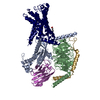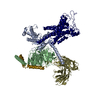+Search query
-Structure paper
| Title | Structural basis for the tethered peptide activation of adhesion GPCRs. |
|---|---|
| Journal, issue, pages | Nature, Vol. 604, Issue 7907, Page 763-770, Year 2022 |
| Publish date | Apr 13, 2022 |
 Authors Authors | Yu-Qi Ping / Peng Xiao / Fan Yang / Ru-Jia Zhao / Sheng-Chao Guo / Xu Yan / Xiang Wu / Chao Zhang / Yan Lu / Fenghui Zhao / Fulai Zhou / Yue-Tong Xi / Wanchao Yin / Feng-Zhen Liu / Dong-Fang He / Dao-Lai Zhang / Zhong-Liang Zhu / Yi Jiang / Lutao Du / Shi-Qing Feng / Torsten Schöneberg / Ines Liebscher / H Eric Xu / Jin-Peng Sun /   |
| PubMed Abstract | Adhesion G-protein-coupled receptors (aGPCRs) are important for organogenesis, neurodevelopment, reproduction and other processes. Many aGPCRs are activated by a conserved internal (tethered) agonist ...Adhesion G-protein-coupled receptors (aGPCRs) are important for organogenesis, neurodevelopment, reproduction and other processes. Many aGPCRs are activated by a conserved internal (tethered) agonist sequence known as the Stachel sequence. Here, we report the cryogenic electron microscopy (cryo-EM) structures of two aGPCRs in complex with G: GPR133 and GPR114. The structures indicate that the Stachel sequences of both receptors assume an α-helical-bulge-β-sheet structure and insert into a binding site formed by the transmembrane domain (TMD). A hydrophobic interaction motif (HIM) within the Stachel sequence mediates most of the intramolecular interactions with the TMD. Combined with the cryo-EM structures, biochemical characterization of the HIM motif provides insight into the cross-reactivity and selectivity of the Stachel sequences. Two interconnected mechanisms, the sensing of Stachel sequences by the conserved 'toggle switch' W and the constitution of a hydrogen-bond network formed by Q/Y and the P/VφφG motif (φ indicates a hydrophobic residue), are important in Stachel sequence-mediated receptor activation and G coupling. Notably, this network stabilizes kink formation in TM helices 6 and 7 (TM6 and TM7, respectively). A common G-binding interface is observed between the two aGPCRs, and GPR114 has an extended TM7 that forms unique interactions with G. Our structures reveal the detailed mechanisms of aGPCR activation by Stachel sequences and their G coupling. |
 External links External links |  Nature / Nature /  PubMed:35418678 PubMed:35418678 |
| Methods | EM (single particle) |
| Resolution | 3 - 3.3 Å |
| Structure data | EMDB-31232, PDB-7ept: EMDB-31254, PDB-7eq1: |
| Chemicals |  ChemComp-PLM: |
| Source |
|
 Keywords Keywords | STRUCTURAL PROTEIN / adhesion GPCR / GPR133 / aGPCR-G protein complex |
 Movie
Movie Controller
Controller Structure viewers
Structure viewers About Yorodumi Papers
About Yorodumi Papers







 homo sapiens (human)
homo sapiens (human)
